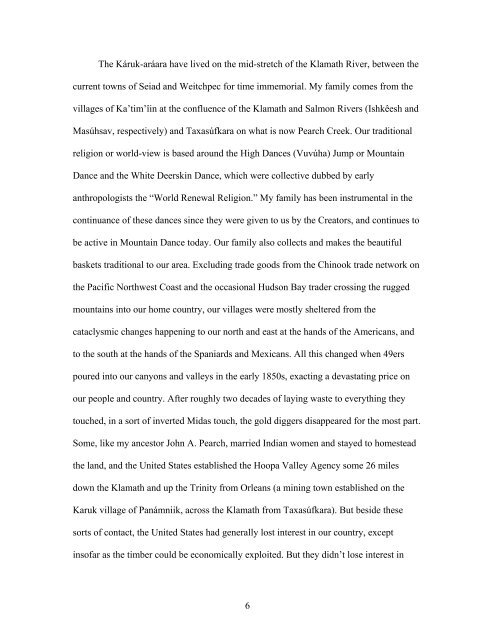The Intersection of Karuk Storytelling and Education
The Intersection of Karuk Storytelling and Education
The Intersection of Karuk Storytelling and Education
Create successful ePaper yourself
Turn your PDF publications into a flip-book with our unique Google optimized e-Paper software.
<strong>The</strong> Káruk-aráara have lived on the mid-stretch <strong>of</strong> the Klamath River, between the<br />
current towns <strong>of</strong> Seiad <strong>and</strong> Weitchpec for time immemorial. My family comes from the<br />
villages <strong>of</strong> Ka’tim’îin at the confluence <strong>of</strong> the Klamath <strong>and</strong> Salmon Rivers (Ishkêesh <strong>and</strong><br />
Masúhsav, respectively) <strong>and</strong> Taxasúfkara on what is now Pearch Creek. Our traditional<br />
religion or world-view is based around the High Dances (Vuvúha) Jump or Mountain<br />
Dance <strong>and</strong> the White Deerskin Dance, which were collective dubbed by early<br />
anthropologists the “World Renewal Religion.” My family has been instrumental in the<br />
continuance <strong>of</strong> these dances since they were given to us by the Creators, <strong>and</strong> continues to<br />
be active in Mountain Dance today. Our family also collects <strong>and</strong> makes the beautiful<br />
baskets traditional to our area. Excluding trade goods from the Chinook trade network on<br />
the Pacific Northwest Coast <strong>and</strong> the occasional Hudson Bay trader crossing the rugged<br />
mountains into our home country, our villages were mostly sheltered from the<br />
cataclysmic changes happening to our north <strong>and</strong> east at the h<strong>and</strong>s <strong>of</strong> the Americans, <strong>and</strong><br />
to the south at the h<strong>and</strong>s <strong>of</strong> the Spaniards <strong>and</strong> Mexicans. All this changed when 49ers<br />
poured into our canyons <strong>and</strong> valleys in the early 1850s, exacting a devastating price on<br />
our people <strong>and</strong> country. After roughly two decades <strong>of</strong> laying waste to everything they<br />
touched, in a sort <strong>of</strong> inverted Midas touch, the gold diggers disappeared for the most part.<br />
Some, like my ancestor John A. Pearch, married Indian women <strong>and</strong> stayed to homestead<br />
the l<strong>and</strong>, <strong>and</strong> the United States established the Hoopa Valley Agency some 26 miles<br />
down the Klamath <strong>and</strong> up the Trinity from Orleans (a mining town established on the<br />
<strong>Karuk</strong> village <strong>of</strong> Panámniik, across the Klamath from Taxasúfkara). But beside these<br />
sorts <strong>of</strong> contact, the United States had generally lost interest in our country, except<br />
ins<strong>of</strong>ar as the timber could be economically exploited. But they didn’t lose interest in<br />
6
















